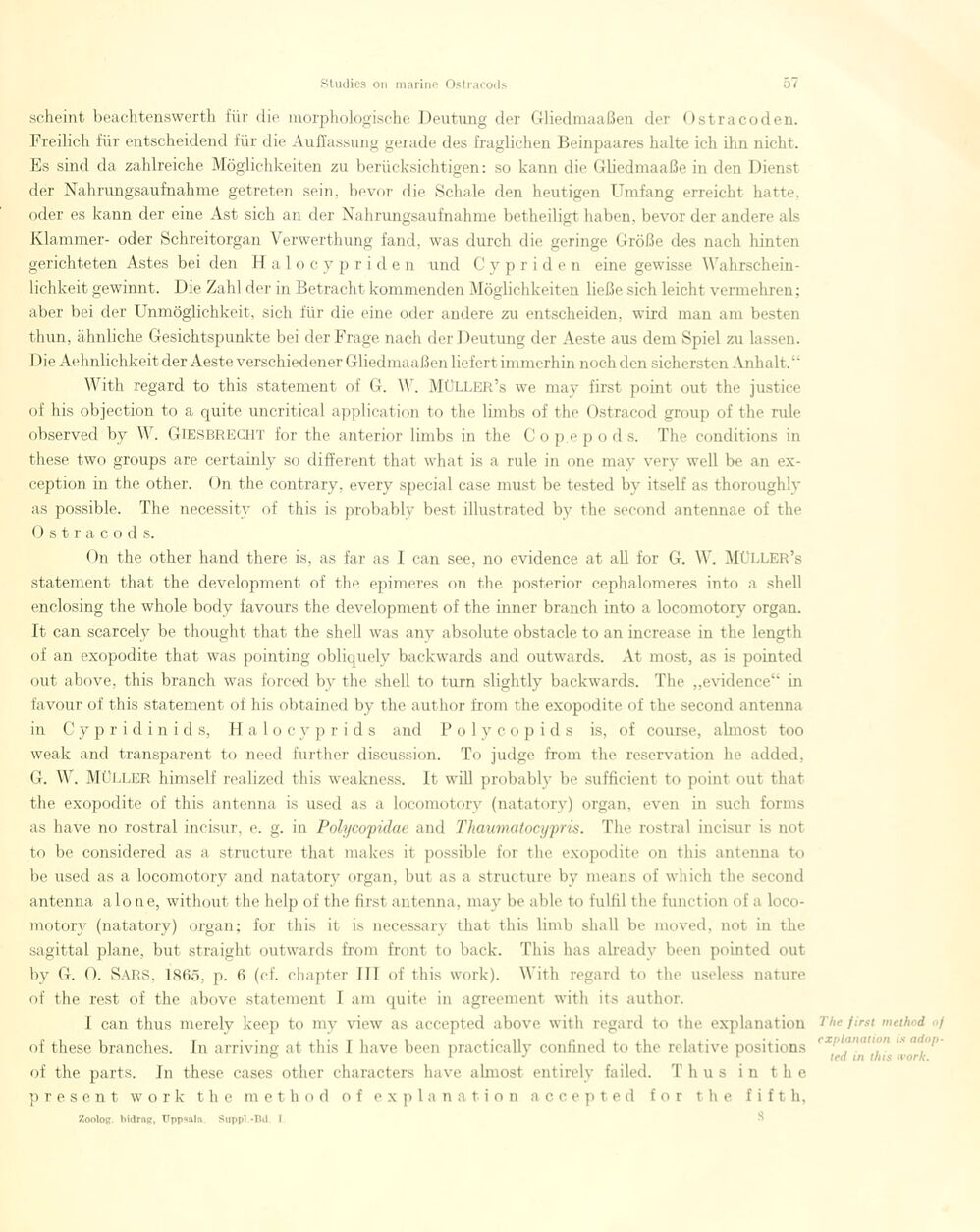
Full resolution (JPEG) - On this page / på denna sida - Sidor ...

<< prev. page << föreg. sida << >> nästa sida >> next page >>
Below is the raw OCR text
from the above scanned image.
Do you see an error? Proofread the page now!
Här nedan syns maskintolkade texten från faksimilbilden ovan.
Ser du något fel? Korrekturläs sidan nu!
This page has never been proofread. / Denna sida har aldrig korrekturlästs.
scheint beachtenswerth für die. morphologische Deutung der Gliedmaaßen der Ostracoden.
Freilich für entscheidend für die Auffassung gerade des fraglichen Beinpaares halte ich ihn nicht.
Es sind da zahlreiche Möglichkeiten zu berücksichtigen: so kann die Gliedmaaße in den Dienst
der Nahrungsaufnahme getreten sein, bevor die Schale den heutigen Umfang erreicht hatte,
oder es kann der eine Ast sich an der Nahrungsaufnahme betheiligt haben, bevor der andere als
Klammer- oder Schreitorgan Verwerthung fand, was durch die geringe Größe des nach hinten
gerichteten Astes bei den Halocypriden und C y p r i d e n eine gewisse
Wahrscheinlichkeit gewinnt. Die Zahl der in Betracht kommenden Möglichkeiten ließe sich leicht vermehren;
aber bei der Unmöglichkeit, sich für die eine oder andere zu entscheiden, wird man am besten
thun, ähnliche Gesichtspunkte bei der Frage nach der Deutung der Aeste aus dem Spiel zu lassen.
1 )ie Aehnlichkeit der Aeste verschiedener Gliedmaaßen liefert immerhin noch den sichersten Anhalt.”
With regard to this statement of G. \\. MüLLER’s we may first point out the justice
of his objection to a quite uncritical application to the limbs of the Ostracod group of the rule
observed by \\. GlESBRECHT for the anterior limbs in the C o p.e p o d s. The conditions in
these two groups are certainly so different that what is a rule in one may very well be an
exception in the other. On the contrary, every special case must be tested by itself as thoroughlv
as possible. The necessity of this is probably best illustrated by the second antennae of the
Ostracods.
On the other hand there is, as far as I can see, no evidence at ail for G. W. MüLLER’s
statement that the development of the epimeres on the posterior cephalomeres into a shell
enclosing the whole body favours the development of the inner branch into a locomotory organ.
It can scarcely be thought that the shell was any absolute obstacle to an increase in the length
of an exopodite that was pointing obliquely backwards and outwards. At most, as is pointed
out above, this branch was forced by the shell to turn slightly backwards. The „evidence“ in
favour of this statement of his obtained by the author from the exopodite of the second antenna
in C y p r i d i n i d s, H a 1 o c y p r i d s and P o 1 y c o p i d s is, of course, almost too
weak and transparent to need further discussion. To judge from the reservation he added,
G. W. MÜLLER himself realized this weakness. It will probably be sufficient to point out that
the exopodite of this antenna is used as a locomotory (natatory) organ, even in such forms
as have no rostral incisur, e. g. in Polycopidae and Thaumatocypris. The rostral incisur is not
to be considered as a structure that makes it possible for the exopodite on this antenna tn
be used as a locomotory and natatory organ, but as a structure by means of which the second
antenna a lo ne, without the help of the first antenna, may be able to fulfil the fonction of a
locomotory (natatory) organ; for this it is necessary that this limb shall be moved, not in the
sagittal plane, but straight outwards from front to back. This has already been pointed out
by G. O. Sars, 186ö, p. 6 (cf. chapter III of this work). With regard to the useless nature
of the rest of the above statement I am quite in agreement with its author.
I can thus merely keep to my view as accepted above with regard to the explanatiou
of these branches. In arriving at this I have been practically confined to the relative positions
of the parts. In these cases other characters have almost entirely failed. Thus in the
present work the method of explanatio n accept ed for the fifth,
Zoolog, bidrog, Uppsolo. Suppl.-Bd. I.
The first method of
exploitation is
adopted in this work.
<< prev. page << föreg. sida << >> nästa sida >> next page >>